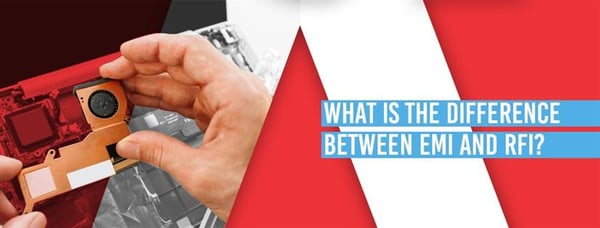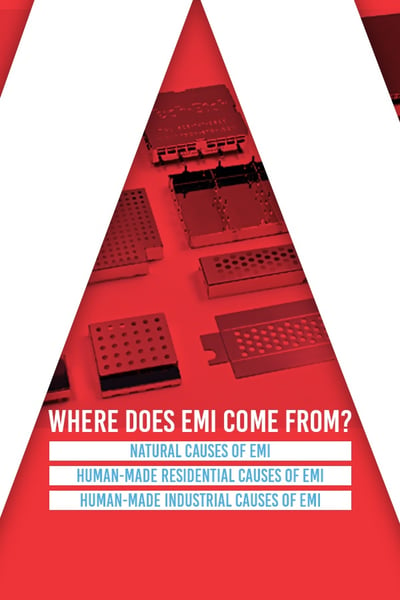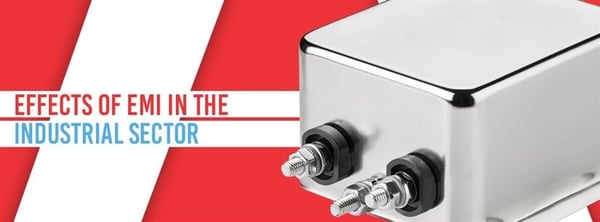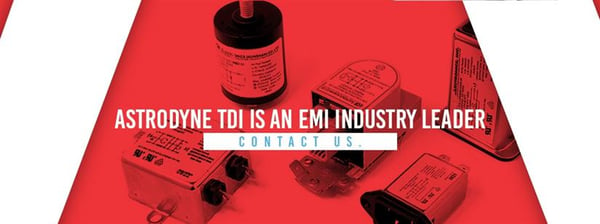RESOURCES
EMI Filter Basics
Electronic devices play a vital role in nearly every industry, from hospitals to industrial manufacturing, to the military. Specific devices rely on uninterrupted and dependable electricity to operate correctly. However, as more and more electronic devices enter the market, they create electromagnetic interference that can cause these devices to malfunction, crash or fail. To protect electronic devices and systems from damage, EMI Filters block adverse inferences and allow a steady flow of power. Here, we'll take an in-depth look at EMI fundamentals, EMI filter applications, and the consequences of EMI across various sectors.
What is EMI?
Electromagnetic interference (EMI) occurs when unwanted electric currents interrupt the intended currents an electronic device is supposed to receive. These disruptive currents — often called "noise" or "electromagnetic noise" — can come from an external source or get created by other components inside the device.
When EMI occurs, it disrupts the functioning of the device and can cause unintended operations to occur. Depending on the severity of the disruption, EMI may impact the quality of the signal the device receives, cause a component to fail or malfunction temporarily, or permanently damage the electronic device.
Find an EMI/EMC Filter Solution for your next project.
What Are the Two Types of EMI?
There are two main types of EMI — conducted EMI and radiated EMI. Conducted EMI goes through conductors, such as wires or power lines, while radiated EMI travels through the air and does not require a conductor. Both conducted and radiated EMI can impact the performance of electronic devices through impairment, degradation, malfunctioning or system failure.

What is the Difference Between EMI and RFI?
You may hear people use EMI and RFI interchangeably when referring to electromagnetic disturbances. However, EMI and RFI filters are not identical.
What is RFI? The term, which is an acronym for radio frequency interference, refers to noise that falls on the radio frequency spectrum within the electromagnetic frequency spectrum. Meanwhile, EMI refers to any frequency of electromagnetic noise. In other words, RFI is a subset of EMI and includes only electromagnetic currents with a frequency between 3 kilohertz and 300 gigahertz. Just like EMI, RFI can be conducted or radiated and can cause a variety of problems with electronic devices.
What is EMC?
Another often-used term when discussing EMI is electromagnetic compatibility or EMC. EMC describes how a device functions or performs in an environment of electromagnetic noise. EMC includes two factors — a device's tolerance to noise, also known as "noise immunity," and how much noise it produces. Devices must be able to operate correctly and securely in an environment with a certain level of electromagnetic noise and must not produce EMI at levels or frequencies that disrupt other devices.
In the U.S., the Federal Communications Commission regulates EMI under Title 47 Part 15, which addresses noise immunity and noise emissions of devices in various industries. Internationally, the International Special Committee for Radio Interference regulates conducted and radiated EMI from industrial, commercial, residential, and automotive sectors. EMC is also subject to regulation by various European standards, including EN55011, which addresses industrial equipment, and EN55022, for IT equipment.

Where Does EMI Come from?
EMI comes from both human-made electrical devices and natural causes. Human-made EMI is most often the result of electronics or electrical circuits, but can also result from switching systems or changes in large currents. Human-made causes of EMI span both residential and industrial sectors and some devices can also create noise or interference between internal components.
1. Natural Causes of EMI
What causes natural EMI?
Naturally occurring EMI can come from a variety of sources, including:
- Lightning strikes
- Solar flares
- Cosmic noise
- Static electricity
- Atmospheric electrical storms
- Solar magnetic storms
- Dust storms
- Snowstorms
- The sun
Natural EMI can occur suddenly and have a severe impact on inadequately protected electrical devices. More substantial natural electromagnetic interference, such as solar flares or electrical storms, can impact military equipment or transportation technologies. The sun can cause disruptions to satellite transmissions if it appears directly behind a satellite and the electromagnetic noise masks the satellite's transmission. On a smaller scale, naturally occurring EMI like snowstorms may cause radio static or disrupt cell phone signals.
2. Human-Made Residential Cause of EMI
What causes residential EMI?
Residential causes of EMI often come from devices that operate using a wireless signal but also emanate from a variety of other electronic appliances. While EMI from residential devices often does not inflict severe or permanent damage, it can still cause annoying disruptions to other devices in the home and lead to poor performance of electronics.
Here are a few common causes of EMI in a residential setting:
- Cell phones
- Laptops
- Wi-Fi devices
- Bluetooth devices
- Baby monitors
- Microwaves
- Toaster ovens
- Electric blankets
- Heating pads
- Heaters
- Lamps
As more and more electronic devices get developed and used, the impact of residential sources of EMI continues to grow. With more people using electronic devices like cell phones and computers, there is a higher density of electromagnetic currents in the environment. Because people are using more devices continuously and in closer proximity, these devices are more likely to cause and become a victim of EMI.
The improved performance of electronic devices also increases the electromagnetic interference they can cause. As electronics are subject to increasingly stringent performance expectations, these devices operate on a higher frequency and produce electromagnetic noise across a broader frequency range than in the past. EMI filters designed to block electromagnetic noise at a specific frequency may not protect against the higher frequencies produced by new devices.
3. Human-Made Industrial Causes of EMI
What causes industrial EMI?
Industrial causes of EMI are often larger-scale and can cause severe interferences with essential technologies. There are several different industrial sources of EMI that produce ambient electromagnetic energy with a widespread impact. Industrial EMI can cause disruptions to hospitals, military operations, and even the local power grid. Here are some common EMI sources in the industrial sector.
- Electric motors and generators: Electric motors and generators can produce a large amount of high-frequency noise and sometimes operate on a continuous cycle for uninterrupted power in factories and manufacturing plants.
- Cellular networks and telephone transmissions: Both wired and wireless telecommunications produce EMI. As the cellular grid continues to grow and more consumers use cell phones, the noise from cell networks becomes a more severe threat to other electronics and devices.
- Television transmissions: Like cellular transmissions, television transmissions can also cause EMI to residential and industrial devices.
- Radio and satellite: Radio and satellite waves transmitted across the country can cause interference with cellular networks or with sensitive equipment.
- Grid power: Transmission lines in the electrical grid often have high voltage and low frequencies that can disrupt certain electronics. Disruptions in grid power — such as voltage surges, voltage dips or spikes, blackouts, and brownouts — can also result in electromagnetic interference in devices and equipment connected to grid power.
- Railroads and mass transportation systems: Operating systems for trains and mass transportation can produce EMI from their propulsion system, signaling systems, control systems, and other processes. These systems operate at high voltages and currents that can impact other transportation system components or electrical devices in facilities located near railroads.
- Medical equipment: Many technologies in the medical field can produce EMI, including life support, X-ray equipment, MRIs, electrical surgical units, telemetry units, and other assistance equipment. EMI from medical equipment can cause the devices themselves to malfunction or can interfere with other medical technology.
- Other high-frequency sources of EMI: Many industrial processes produce high-frequency EMI from components such as transmitters, transformers, inverters, microprocessors, and controls.
Some industrial causes of EMI affect technologies within the same facility or process, while others — such as grid power interruptions — can cause more widespread disruptions.
Other Types of EMI Categorization
Other ways to categorize EMI include their duration or bandwidth. Depending on the EMI source, the inference can be continuous or sporadic.
What is Continuous Interference?
Continuous interference occurs when a source produces a prolonged signal, such as a circuit or steadily operating motor.
What is Sporadic Interference?
EMI that occurs only sporadically is impulse noise. Sporadic EMI includes temporary interruptions like lightning or a power surge.
It is also possible to categorize the different types of EMI by their bandwidth. Narrowband EMI often comes from a single source, while broadband EMI comes from multiple sources or signals in a system, such as a wireless network or power grid.
Why is EMI a Problem?
EMI can cause a range of issues for residential and industrial devices, from a temporary impact to permanent damage. In its mildest form, EMI may cause annoying disruptions to the quality of performance of a device, such as poor cell phone reception. In more severe instances, EMI can lead to fatal consequences, such as failure or malfunction of essential medical equipment. The impact of EMI depends on many factors, including the duration of the interference, the environment in which it takes place, and the noise immunity of the device.
Effects of EMI in the Residential Sector
In the residential sector, EMI can cause home appliances and devices to malfunction or short out. If a power surge occurs to inadequately protected appliances, it can inflict permanent damage.
What are the residential effects of EMI?
- Disruptions to wireless devices: EMI can cause bad cell phone reception or poor performance of mobile devices. Wi-Fi and Bluetooth devices may experience reliability issues that can be frustrating to everyday life.
- Malfunction of computers: Small EMI disruptions to computers can cause monitor flicker or poor performance, whereas a considerable interruption like a power surge could cause the computer to crash, resulting in data loss or permanent damage to the computer's hard drive.
- Damage to large appliances: EMI can have the biggest impact on major home appliances like washing machines, dryers, refrigerators, dishwashers, and microwaves. Even home heating and cooling systems can be susceptible to damage from EMI. When noise interferes with these appliances, it can cause malfunctions and permanent damage to the electrical circuit.
- Disruptions to other residential devices: Almost any electronic or electrical device may be subject to damage from EMI, including smaller home devices such as blenders, mixers, vacuum cleaners, and electric power tools.
As manufacturers continue to design appliances and electronic devices to consume less power, it has also made them more susceptible to damage from EMI. Energy-conscious devices that run on a lower voltage and at a higher frequency often have decreased noise immunity and can incur damage from lower levels of noise.

Effects of EMI in the Industrial Sector
In the industrial sector, EMI can affect devices across industries and lead to downtime, data loss, or permanent damage to equipment. In the military and medical fields, the impacts of EMI on mission-critical functions can be even more severe.
What are the industrial effects of EMI?
- Disruption in television, radio, and telecommunications: When EMI impacts satellite performance, it can result in abnormal noises in radio transmissions or disrupted video in television transmissions. This effect is particularly evident in areas with weaker radio or telephone signals. If EMI impacts telecommunications, it can lead to poor reception or unreliable service.
- Failure of hospital equipment: Many types of medical equipment are vulnerable to electromagnetic noise and can easily malfunction if unshielded from EMI. Life support equipment monitors weak body signals, making it highly susceptible to damage or failure from EMI. Devices like pacemakers and hearing aids can also malfunction or fail due to EMI. Failure of hospital equipment can lead to death or other severe consequences.
- Failure of military equipment: Mission-critical military equipment can fail because of ambient EMI or disruptions to its power supply. It is, therefore, essential to protect military equipment from high-powered electromagnetic pulse (HEMP) threats, a form of weaponized EMI. HEMP threats and other sources of EMI can cause the loss of sensitive data or disrupt military communications or operations.
What is an EMI Filter?
EMI filters, also called EMI suppression filters, are an effective way to protect against the harmful impacts of electromagnetic interference.
What Does an EMI Filter Do?
When attached to devices or circuits, an EMI filter can suppress electromagnetic noise transmitted through conduction. These filters extract any unwanted current conducted through wiring or cables while allowing desirable currents to flow freely. An EMI filter that suppresses noise from grid power is also called an EMI power line filter.
How Do EMI Filters Work?
Most electromagnetic noise is in a higher frequency range, so EMI filters are often low-pass filters that sift out high frequencies while letting lower frequencies pass through. Different EMI line filters suppress specific frequencies of noise while allowing others to flow unimpeded. After the filtering process, electromagnetic noise gets diverted away from the device and to the ground. Some EMI filters may also route unwanted currents back to the noise source or absorb them.
Because EMI filters only protect against conducted EMI, they often pair with shields that block radiated EMI. An unshielded EMI filter can still transmit noise through the air to damage the device. Noise can get emitted from a wire on one side of the EMI filter and then travel to the device by recoupling with the wire on the other side.
Adding a shield at the attachment point of the electromagnetic interference filter can effectively block all forms of EMI. However, if there is only a small length of conductor between the filter and the source of EMI, using a filter alone can be sufficient.
EMI Filter Applications
Different EMI filters can apply in various ways to most effectively protect against damage from electromagnetic noise. EMI filters block different frequencies of noise and meet varying regulations in different industries. Here are a few types of EMI filters in residential and industrial applications.
- Appliances and washing machines: White goods EMI filters suppress electromagnetic noise for a variety of home appliances from washing machines to treadmills. These filters ensure devices meet electromagnetic compatibility regulations and help protect them from EMI damage that can impact their performance.
- Single-phase: Single-phase EMI filters are effective for smaller equipment, such as home appliances and electronics, as well as industrial applications, such as food service equipment, power supplies, and telecommunications. A single-phase EMI filter can also be compatible with fitness equipment and motor controls.
- Three-phase: For more stringent EMI suppression, three-phase EMI filters can block higher levels of noise through a three-stage filtering system. Three-phase EMI filters are for use in high-power applications such as industrial machinery and motors, medical equipment, test equipment, and industrial tools.
- Military: EMI filters for military applications specifically meet regulations and compliance standards for EMC of military devices. These reliable EMI filters protect against damage to aerospace and military communication systems for secure operations. EMI filters designed for HEMP protection are also available to protect against EMI threats.
- Medical-grade EMI filters: Medical-grade EMI filters meet current requirements for medical applications and protect sensitive medical equipment from damage. EMI filters for MRI rooms are purpose-built to create a secure test chamber free of EMI from lighting, intercoms, and other sources of outside noise. Effective and reliable EMI filters for medical applications can be life-saving protection against electromagnetic noise interference.
Depending on the desired application, the impact of EMI filters can include shutting out undesirable electromagnetic noise and protecting devices and electrical systems from damage.

Astrodyne TDI is an EMI Industry Leader
If you need effective EMI protection, Astrodyne TDI can provide a durable and dependable EMI filter for every application. Our inventory includes reliable EMI filters for specialized applications in the military and medical fields, as well as cost-effective EMI filters for residential and industrial use. For applications that require a custom solution, our expert team can design an EMI suppression filter that meets your specific requirements.
With more than 50 years of experience, Astrodyne TDI is a trusted manufacturer of high-quality EMI filters for medical, military, commercial, and residential applications. We design all our EMI filters to meet industry standards and comply with EMC regulations. Explore our selection of EMI filters or submit a custom quote request for the perfect EMI filter for your needs. For more information about custom and standard EMI filters from Astrodyne TDI, contact us.

